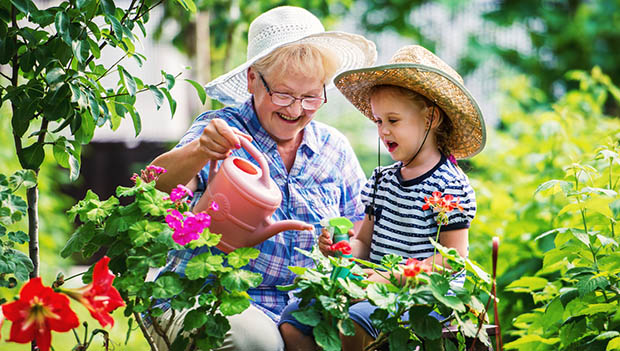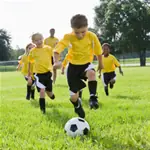
A home garden is a great way to work together as a family in a playful, educational and productive way, and the season for planting is upon us! Involving your child in preparing, planting and maintaining this space in your yard will help them learn more about plants and life and develop skills that will help them feel strong, confident and self-sufficient as they work on something the whole family can benefit from.
To see a seed grow to maturity in the form of a flower, fruit, vegetable or flourishing green plant is a wonderful reward, and the work that gets a plant to this point can be engaging play for little ones. A garden is a big responsibility with its daily maintenance—a perfect learning environment for kids.
From giving them their own set of gardening tools to involving them in the process of preparing for and picking their plants, here's a list of things to consider as you work to engage your child in gardening this spring.
Real (Not Plastic) Tools
Before you begin, pick out a set of real gardening tools (and gloves fit for small hands) for your young helper! From kitchenettes to work benches, most children are familiar with the plastic play sets that allow them to imagine and pretend they're chefs or engineers. When it comes to involving them in the work required to support a garden, a set of real tools will not only work better for them than plastic play tools but will help keep them engaged as well! Sure, not all garden work is going to feel like play—and they won't necessarily always be up for it—but having a set of real tools on hand will help them gain a sense of responsibility in the process!
Out With the Old, in With the New
After the long winter months, your preexisting garden beds are sure to need a bit of a pick-me-up! Set aside time to weed and churn up the dirt with your little one. This is a great way to initiate them to the gardening process—they'll be able to get their hands dirty and help you with a part of gardening that has very few restrictions. As mentioned above, a set of new tools will help make this "chore" appealing, and it gives you an opportunity to help them imagine the plants you're making room for (ask them what they'd like to see), and discuss why these voluntary greens (weeds) need to go!
A Space of Their Own
Whether or not you already have a garden established in your yard, another way to include your child in the gardening process is by establishing a garden space as their very own to plant and care for. This could include setting up a small wired fence to enclose a space or building a new box just for them. If you don't want to build a box from scratch, there are also some great ideas out there for reestablishing old containers as garden beds that might work perfectly for their first garden. Click here for a few ideas.
Choosing a Location
Prior to your little one selecting what types of seeds they want to plant, it will help to know what area of the backyard you're planning to put your garden or planter box. Together you can spend a few days charting the sunlight in your yard starting in the morning and checking throughout the day to see how many hours of light you're getting in each part of your yard. This data collection will allow them to use the "required hours of sunlight" datapoint on the seed packages to determine if they're a good pick for that area.
Choosing the Seeds
When first approaching a garden, sometimes the quickest way to get plant life in the yard is to buy the prepackaged and grown plants. This will establish a garden that needs care (water, nutrients, light, pest control), but it doesn't offer a full picture of the growth and gardening process. If you're able to nurture plants from seed to flowers (or harvest), your child will learn a great deal more from the process and have much more context for the purpose behind each component of their work in maintaining a healthy garden.
A few things to consider when deciding what you would like to plant include the season, the soil, sunlight/location, what your family likes to eat and what plants are the easiest to grow. Here is a link with suggestions of seeds that are perfect for young gardeners!
Pest Identification and How to Manage Them
Once you've decided what seeds and plants you're going to plant, the next thing you'll need to help your child do (along with watering and nurturing the plant) is to find ways to keep it safe from pests. Some plants are more susceptible than others. For example, roses and aphids along with tomatoes and caterpillar worms are a few classic plant-pest pairings. Once you know what pests are likely to intervene with the growth and enjoyment of your garden, it's easy to come up with chemical-free means of protecting it—nets, soapy water solutions, etc. At the very least, help your child keep an eye on the bugs and pests that venture into your garden at each watering, and give them a place to relocate slugs, snails and other pests if they see them on a plant.
Early Spring Frost Management
Along with preparing to protect your garden from pests, you'll want to work with your child to protect their garden from the unpredictable shifts in temperature in the early spring months. Frost can set in quickly overnight, leaving any early hard work at risk of needing some unnecessary upkeep. To avoid this, establish a way of protecting your plants either by having a place to move small containers inside, or by covering the garden boxes and plants with blankets and cardboard overnight in the cooler weeks. Plants are especially susceptible to frost in their early stages, so helping your seeds establish themselves indoors or in a greenhouse is best. Your child may even enjoy this opportunity to tuck their plants into bed before they go to sleep themselves!
Kid Gardening Resources and Books
Ultimately, gardening is a waiting game where the fruits of your labor don't come to fruition overnight. This can be frustrating for little ones, so along with selecting faster growing seeds and plants, having a plan for maintaining excitement for their garden during the weeks and days of waiting will help keep them engaged! A visit to your local library or establishing a collection of gardening books and stories for kids is one way to do this. Not only will this help provide context for their garden efforts, but you're likely to find a ton of information out there to help better inform their work. Here's a link to a number of garden books for kids.
READ THIS NEXT: Kid's Guide to Winter Plant Identification









Discuss This Article